Search the Special Collections and Archives Portal
Search Results
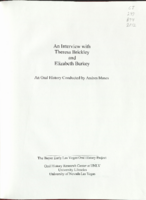
Transcript of interview with Theresa Brickley and Liz Burkey by Andres Moses, January 27, 2006
Date
2006-01-27
Archival Collection
Description
Theresa Brickley and Elizabeth Burkey come from very different corners of the world, but were united by dance in Las Vegas. Theresa was bom and raised in Tokyo, and immigrated to the United States with her American husband. Elizabeth, better known as Liz, was bom in Detroit, Michigan into a family of performance artists. Theresa's first dance job was disrupted by World War II, while Liz's break came when becoming a Rockette at Radio City Music Hall. Migrating to Las Vegas from Seattle and California respectively, the two met as performers in the Sun City Dance Company, and became the best of friends. They have performed all over the city, including Sahara, Rio, and Mirage, to name a few.
Text

Transcript of interview with Myrtle Banks by George Williams, March 15, 1981
Date
1981-03-15
Archival Collection
Description
George Williams interviews Myrtle Banks (b. 1923) in her home while Lucille Bell is also present and occasionally provides additional commentary. They discuss African American history in Nevada, specifically in the context of job opportunities, relationships with whites, and the social and political changes that took place over time. Banks also discusses the riots of the 1960s, changes in crime rates and their effect on perception of safety, constructional increases and population growth, shopping and price changes on various products, and how gambling and entertainment defined Las Vegas.
Text

Transcript of interview with Thomas Barbarite by Dennis Chamberland, March 3, 1981
Date
1981-03-03
Archival Collection
Description
Dennis Chamberland interviews Thomas Barbarite (b. 1932) in his home about his time in Las Vegas and his experiences in the casino industry. Barbarite discusses his time at the Four Queens and the Dunes as a dealer as well as his work as a pit boss at the Flamingo, the Aladdin, and Caesars Palace. Chamberland also asks Barbarite about the changes over time on the Strip, including the disappearance of lounge shows and expansion of larger shows on the Strip. Barbarite also discusses the involvement of the mob in Las Vegas, particularly the influence of Bugsy Siegel in the operation of various properties.
Text

Transcript of interview with Mildred Bardy by Deborah Grant, March 11, 1981
Date
1981-03-11
Archival Collection
Description
Deborah Grant interviews Mildred Bardy (b. 1907) at their place of employment, Joseph Magnin, a specialty clothing department store located on the Strip. Bardy discusses the famous celebrities who would come to purchase clothing there, as well as the costumes that were made for the Helldorado Parade. The two also discuss some of the changes in Las Vegas over time, particularly the changes in fashion styles.
Text

Transcript of interview with Barbara Barnett by Charles Chesnutt, March 8, 1981
Date
1981-03-08
Archival Collection
Description
Charles Chesnutt interviews Barbara Barnett (b. 1936) at Chesnutt’s home. The two discuss Barnett’s experiences as a nurse in different units within several of early hospitals in Las Vegas, with specific focus on how patients were cared for and how the profession has evolved. Barnett also briefly talks about her time at the Hacienda and what it was like working in a casino. The two also discuss how the city has grown, specifically on social changes, climate change regarding the increase in humidity, and the casino additions to the Strip and Downtown areas.
Text

Transcript of interview with Lendon Kaye Barney by Kelly Adams, March 3, 1978
Date
1978-03-03
Archival Collection
Description
Kelly Adams interviews Lendon Barney (b. 1925) about his experiences as an early resident of Bunkerville, Nevada. Barney also discusses his membership in the Mormon church, as well as his career as a music teacher for schools in Clark County. Barney also describes some of the early development and changes in Nevada, such as the population growth, changes in housing prices, and the building of highways.
Text
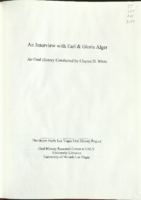
Transcript of interview with Earl and Gloria Alger by Claytee D. White, October 29, 2009
Date
2009-10-29
Archival Collection
Description
Earl and Gloria Alger were born in the early 1930s, met at the Mormon Church, dated in high school and have spent their entire lives in Las Vegas. Earl's story begins with his father arriving to take a construction job at the Boulder Dam. For a year he worked and saved to move his family from Utah to Las Vegas. The family lived on the Westside and Earl recalls he and his brother sharing a tent as their bedroom for a while. Gloria remembers growing up on Garcia Street in the downtown area. Her parents took her to a Liberace show for her 16th birthday, but other than that their lives were centered around the Mormon church. Her great-grandfather Torrel Lewis was one of the original pioneers from Salt Lake City. They describe the good old days of the "old Ranch", "Twin Lakes", and "frogging"; of the changed attitudes of working in gaming by the Mormon community and the more recent changes due to corporation leaders and increased traffic of the population growth.
Text
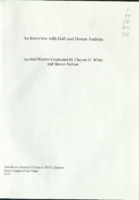
Transcript of interview with Gail and Donna Andress by Claytee White, November 26, 2008
Date
2008-11-26
Archival Collection
Description
The memories and recollections of Gail and Donna Hanley Andress provide a rare and fascinating look at the early days of Las Vegas. They arrived in the early 1930s and, except for relocations due to military service in World War Two, remained active citizens of the town until retiring to Nelson, Nevada, in 1987. Gail's careers spanned a number of occupations, from car dealerships to construction work, and Donna volunteered to serve in a number of community organizations, principally the Service League, the forerunner of the Junior League of Las Vegas. They insist that Nelson is not far from Las Vegas and have remained interested and supportive of many projects in both communities.
Text
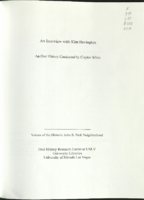
Transcript of interview with Kim Bavington by Claytee White, July 15, 2010
Date
2010-07-15
Archival Collection
Description
In 1964, Kim Bavington's parents moved to Las Vegas when she was six months old. Her father was an industrial designer and mother was an art instructor. In this interview she speaks of growing up in Las Vegas and the various locations where she lived over the course of years, including: eighteen years in Francisco Park, an apartment in Spring Valley, a first house in Green Valley and eventually a home that she and husband Tim Bavington, an artist, own in John S. Park. Kim earned a Fine Art degree from UNLV and worked at a sundry of jobs to support herself. She reflects on this and on how living in Paris, where she took art classes at Sorbonne for six months, dramatically altered her perspective of Las Vegas. Eventually a neighbor situation further changed her feelings about living in a gated community and she knew she wanted to move to what she calls "an old fashion neighborhood." The house search lead her and future husband Tim to John S. Park Neighborhood and a once "super Mid-Century Modem ranch" house. Their large five-bedroom house was built in 1963, has been restored to its original state and is furnished with 1950s furniture.
Text
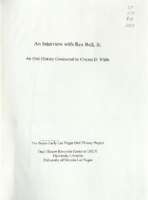
Transcript of interview with Rex Bell Jr. by Claytee D. White, March 2, 2010
Date
2010-03-02
Archival Collection
Description
Growing up on the Walking Box Ranch as the son of movie stars Rex Bell and Clara Bow, attending law school, work in Las Vegas, race relations, and owning a law practice.
Text
Pagination
Refine my results
Content Type
Creator or Contributor
Subject
Archival Collection
Digital Project
Resource Type
Year
Material Type
Place
Language
